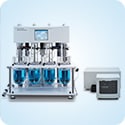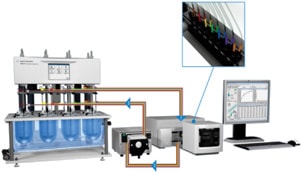Access Agilent eNewsletter, June 2014
>> Update My Profile | Subscribe to Access Agilent | Article Directory

Ask the expert: Does the Agilent Online UV Dissolution System really help labs to work smarter – not harder?
By Dan Spisak
Agilent Product Manager, Dissolution Systems
Aren’t we always looking for ways to make things better? This is especially true when inspecting our daily laboratory workflow. Asking if Agilent Online UV Dissolution Systems can help us work smarter is a valuable question. We address the answer in four expanded questions that pose typical problem areas and discuss how each of them could be improved – specifically as they relate to dissolution testing. Each discussion provides a real-world example of how Agilent’s online dissolution solutions – including the new Cary 8454 UV Dissolution System – can directly enhance these situations.
Better use of time
As a laboratory analyst, chemist or supervisor, are you spending your time the right way? Are there ways to automate or delegate your current tasks so you can accomplish other goals?
Preparing and executing a dissolution test requires many tasks that you could potentially automate. Depending on the length of the test and number of sample timepoints, automating the test and the analysis itself will most likely provide the biggest benefit. Now instead of constantly checking the clock or responding to the sample timers, you can trust an automated system to take and analyze those samples – allowing you to prepare for additional tests, review data or catch up on relevant industry topics.
It’s also worth mentioning that while validation of a dissolution method with an automated system requires an initial investment in time, you’ll typically realize a positive return in time savings in just a matter of weeks.

Figure 1. Agilent Cary 8454 UV-Vis.
Why Agilent:
Agilent offers two UV-Vis spectrophotometers, both capable of supporting an online UV dissolution system: the Cary 60 UV-Vis spectrophotometer and the new Cary 8454 UV-Vis spectrophotometer, which continues the tradition of Agilent’s leading UV-Vis diode array technology (Figure 1).
The Cary 60 UV Dissolution System is available in both a multicell and fiber optic configuration, and boasts an impressive linear range (up to 3.5 Au). The Cary 60 UV can also include the new 850-DS Sampling Station which brings with it sample archival/collection, 0.2 or 0.45 µm filtration and automated cleaning. The Cary 8454 UV Dissolution System offers a variety of scalable solutions – up to four (4) dissolution apparatus may be configured – and promises a seamless transition from its predecessor, the 8453 system. Each system provides distinct advantages, so rely on your needs and experience to choose the solution that’s right for you.
Sample throughput
How should the endless stream of dissolution sample analysis be managed? What’s the best way to maximize the throughput in an efficient and reliable manner?
There’s no one-size-fits-all response to these questions. The first thing to assess is your lab’s particular situation. It’s best to determine what is the actual rate-limiting step in your workflow – i.e., where is the logjam?
If certain parameters of the dissolution method (e.g., filtration, timepoints) prevent online automation, it may be best to simply automate dissolution sample collection and implement a sipper to perform the analysis. Or if the same method is executed repeatedly, you may find that a multi-apparatus online system will provide maximum throughput and efficiency with minimal setup required.
Why Agilent:
Cary 60 UV Dissolution Systems support single or dual-apparatus configurations – with multicell or fiber optic analysis available to accommodate difficult filtering or timepoint frequency needs.
Agilent’s new Cary 8454 system is scalable – with online solutions ranging from one (1) to four (4) dissolution apparatus, all controlled from a single PC with the improved Agilent UV ChemStation software.
For situations where UV-Vis sample analysis alone is the bottleneck, the Cary 8454 system can also be configured with an XY-autosampler and sipper module to expedite this step (Figure 2).

Figure 2. Agilent Cary 8454 system.
Reduction of errors
How should you reduce variability from analyst to analyst? What can be done to limit the time it takes for a failure investigation? Why does it seem like the more automation, the more problems occur?
As with any process, it is important to have a good understanding of how things work in order to efficiently solve issues that may arise. If you’re looking to reduce variability – an inherent trait of humans – an automated system will eliminate many areas of concern. When dissolution sampling position, timing and filtration, filling of flow cells and subsequent analysis are performed in a consistent manner, you reduce manual handling errors and variability. Even if only the analysis is controlled with a sipper, a tremendous positive effect on final results can be achieved.
Differing levels of dissolution automation are readily available, but it’s not always the most expensive or complicated instrumentation that is the best fit for your laboratory. Proper evaluation of your workflow will ensure that the most appropriate solutions are put into place. By understanding where your failures typically occur, systems (or parts of systems) can be implemented to improve daily operations.
Why Agilent:
The primary design focus of Agilent’s dissolution instrumentation is to eliminate sources of external variability and ensure that differences in results are from the dosage form itself. This process begins with the automation-friendly dissolution apparatus (708-DS or 709-DS) to the sampling station (850-DS) and then flows through to the UV-Vis analytical finish (Cary 60 or Cary 8454).
With a single vendor solution, you can be sure that control of instruments and management of methods and data are seamless and secure. To keep automation simple and truly maximize its benefit, understand your workflow to uncover a solution best suited to your needs. Agilent not only has varying levels of options available, but also provides technical assistance to ensure that your goals are achieved.
Optimizing your laboratory equipment
How can you be sure you’re getting the most out of your current equipment? Do you have options for expanding or adding capability to what already exists?
Once the entire workflow is understood and the trouble spots are identified, a closer inspection of available instrumentation can be performed to assess if new purchases need to be made. Your instrument vendor should be able to discuss improvements and upgrades to your existing instrumentation, as well as helping you identify any missing pieces that could improve throughput and efficiency.
 Enlarge
Enlarge
Figure 3. Agilent Cary 8454 system and UV ChemStation software.
Why Agilent:
The online UV dissolution systems from Agilent deliver complete control and analysis for a wide range of dissolution methods – all from a single vendor. The Agilent Cary 8454 system provides a seamless transition from the 8453 system with 3 different configurations. Powered by an enhanced version of Agilent UV ChemStation software (Figure 3), it’s also ideal for single or select multicomponent products.
Agilent stands ready to help you streamline your workflow and improve your overall productivity with a number of outstanding solutions including the Cary 60 UV-Vis spectrophotometer and the new Cary 8454 UV-Vis spectrophotometer. Learn more about Agilent’s online UV Dissolution Systems or join us live for Dissolution Demo at Your Desk. Then put our dissolution systems to work in your lab.
>> Update My Profile | Subscribe to Access Agilent | Article Directory
